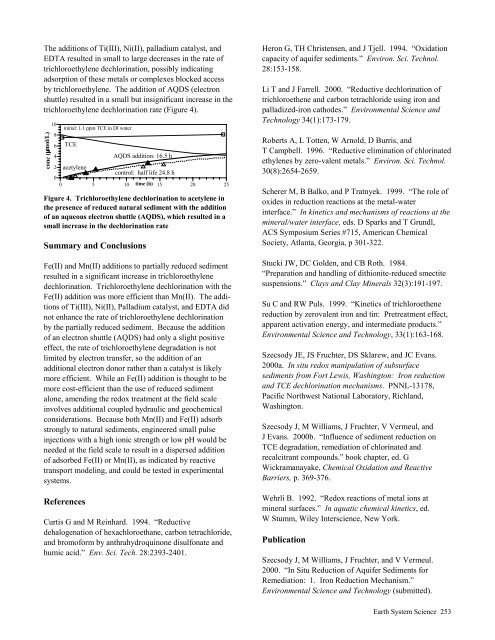PNNL-13501 - Pacific Northwest National Laboratory
PNNL-13501 - Pacific Northwest National Laboratory
PNNL-13501 - Pacific Northwest National Laboratory
Create successful ePaper yourself
Turn your PDF publications into a flip-book with our unique Google optimized e-Paper software.
The additions of Ti(III), Ni(II), palladium catalyst, and<br />
EDTA resulted in small to large decreases in the rate of<br />
trichloroethylene dechlorination, possibly indicating<br />
adsorption of these metals or complexes blocked access<br />
by trichloroethylene. The addition of AQDS (electron<br />
shuttle) resulted in a small but insignificant increase in the<br />
trichloroethylene dechlorination rate (Figure 4).<br />
conc (µmol/L)<br />
10<br />
8<br />
6<br />
4<br />
initial: 1.1 ppm TCE in DI water<br />
TCE<br />
Summary and Conclusions<br />
Fe(II) and Mn(II) additions to partially reduced sediment<br />
resulted in a significant increase in trichloroethylene<br />
dechlorination. Trichloroethylene dechlorination with the<br />
Fe(II) addition was more efficient than Mn(II). The additions<br />
of Ti(III), Ni(II), Palladium catalyst, and EDTA did<br />
not enhance the rate of trichloroethylene dechlorination<br />
by the partially reduced sediment. Because the addition<br />
of an electron shuttle (AQDS) had only a slight positive<br />
effect, the rate of trichloroethylene degradation is not<br />
limited by electron transfer, so the addition of an<br />
additional electron donor rather than a catalyst is likely<br />
more efficient. While an Fe(II) addition is thought to be<br />
more cost-efficient than the use of reduced sediment<br />
alone, amending the redox treatment at the field scale<br />
involves additional coupled hydraulic and geochemical<br />
considerations. Because both Mn(II) and Fe(II) adsorb<br />
strongly to natural sediments, engineered small pulse<br />
injections with a high ionic strength or low pH would be<br />
needed at the field scale to result in a dispersed addition<br />
of adsorbed Fe(II) or Mn(II), as indicated by reactive<br />
transport modeling, and could be tested in experimental<br />
systems.<br />
References<br />
AQDS addition: 16.5 h<br />
2<br />
0<br />
acetylene<br />
control: half life 24.8 h<br />
0 5 10 time (h) 15 20 25<br />
Figure 4. Trichloroethylene dechlorination to acetylene in<br />
the presence of reduced natural sediment with the addition<br />
of an aqueous electron shuttle (AQDS), which resulted in a<br />
small increase in the dechlorination rate<br />
Curtis G and M Reinhard. 1994. “Reductive<br />
dehalogenation of hexachloroethane, carbon tetrachloride,<br />
and bromoform by anthrahydroquinone disulfonate and<br />
humic acid.” Env. Sci. Tech. 28:2393-2401.<br />
Heron G, TH Christensen, and J Tjell. 1994. “Oxidation<br />
capacity of aquifer sediments.” Environ. Sci. Technol.<br />
28:153-158.<br />
Li T and J Farrell. 2000. “Reductive dechlorination of<br />
trichloroethene and carbon tetrachloride using iron and<br />
palladized-iron cathodes.” Environmental Science and<br />
Technology 34(1):173-179.<br />
Roberts A, L Totten, W Arnold, D Burris, and<br />
T Campbell. 1996. “Reductive elimination of chlorinated<br />
ethylenes by zero-valent metals.” Environ. Sci. Technol.<br />
30(8):2654-2659.<br />
Scherer M, B Balko, and P Tratnyek. 1999. “The role of<br />
oxides in reduction reactions at the metal-water<br />
interface.” In kinetics and mechanisms of reactions at the<br />
mineral/water interface, eds. D Sparks and T Grundl,<br />
ACS Symposium Series #715, American Chemical<br />
Society, Atlanta, Georgia, p 301-322.<br />
Stucki JW, DC Golden, and CB Roth. 1984.<br />
“Preparation and handling of dithionite-reduced smectite<br />
suspensions.” Clays and Clay Minerals 32(3):191-197.<br />
Su C and RW Puls. 1999. “Kinetics of trichloroethene<br />
reduction by zerovalent iron and tin: Pretreatment effect,<br />
apparent activation energy, and intermediate products.”<br />
Environmental Science and Technology, 33(1):163-168.<br />
Szecsody JE, JS Fruchter, DS Sklarew, and JC Evans.<br />
2000a. In situ redox manipulation of subsurface<br />
sediments from Fort Lewis, Washington: Iron reduction<br />
and TCE dechlorination mechanisms. <strong>PNNL</strong>-13178,<br />
<strong>Pacific</strong> <strong>Northwest</strong> <strong>National</strong> <strong>Laboratory</strong>, Richland,<br />
Washington.<br />
Szecsody J, M Williams, J Fruchter, V Vermeul, and<br />
J Evans. 2000b. “Influence of sediment reduction on<br />
TCE degradation, remediation of chlorinated and<br />
recalcitrant compounds.” book chapter, ed. G<br />
Wickramanayake, Chemical Oxidation and Reactive<br />
Barriers, p. 369-376.<br />
Wehrli B. 1992. “Redox reactions of metal ions at<br />
mineral surfaces.” In aquatic chemical kinetics, ed.<br />
W Stumm, Wiley Interscience, New York.<br />
Publication<br />
Szecsody J, M Williams, J Fruchter, and V Vermeul.<br />
2000. “In Situ Reduction of Aquifer Sediments for<br />
Remediation: 1. Iron Reduction Mechanism.”<br />
Environmental Science and Technology (submitted).<br />
Earth System Science 253

















